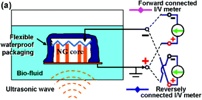Nanogenerators Powered By Heartbeat
Posted in General Science on Jul 07, 2007
 Scientists from Georgian Institute of Technology created a prototype nanogenerator that can generate electricity inside a human body.
Scientists from Georgian Institute of Technology created a prototype nanogenerator that can generate electricity inside a human body.
Tiny little devices traveling in our bloodstream while performing complete blood analysis and monitoring our well-being is the future of implantable biosensors. However, these nanorobots will need to be self-powered and there are two ways for achieving it – either to use a battery or to harvest energy from the environment.
Generating electricity “on-board” is a very attractive option for in vivo medical application because biological systems provide a great medium for converting chemical, thermal, or mechanical energy to electricity ensuring a lifetime operation.
Zhong Lin Wang and colleagues have developed a DC (direct-current) nanogenerator that converts mechanical energy into electricity. The basic principle is to use piezoelectric and semiconducting coupled nanowires (NWs), such as zinc oxide (ZnO). The nanogenerator used in the experiments was 2 mm2 and had a million of nanowires.
This nanogenerator has the potential of directly convert hydraulic energy in the human body, such as flow of body fluid, blood flow, heart beat, and contraction of blood vessels, into electric energy. But for now, a prototype of the nanogenerator is driven by ultrasonic waves through a metal frame suspended in air and creates a 25-35 nA current while submerged in 0.9% NaCl – a normal saline solution.
Reference: “Integrated Nanogenerators in Biofluid”, Nano Letters doi: 10.1021/nl0712567 S1530-6984(07)01256-8
69 Responses to “Nanogenerators Powered By Heartbeat”
Leave a Reply to mahesh
Tag Cloud
-
adsorbent
benzene
china
chlorophyll
chromatographic
chromatography
column chromatography
CZE
DESI
electromagnetic induction
electrospray
ELISA
eluent
explosives
forensic
furosine
Gas Chromatography
GC/MS
History
HPLC
IC
isoflavones
lab-on-a-chip
LCMS
maldi tof
Mass Spectrometry
microfluidic
nano
Nano HPLC
nanoliquid
nanoscale
nanostream
nanotechnology
nanotubes
News
organic molecule
protein
Rickettsia
rmsf
rocky mountain spotted fever
science
soy
TCM
ticks
tsvet



generic for zofran
voltaren gel at walmart
tamsulosin ejakulationsstörung
hydroxyzine and venlafaxine
can you take tizanidine while pregnant
ivermectin cream 5%
sitagliptin for heart failure
pronounce spironolactone
synthroid rxlist
can protonix be crushed
glimepiride vs repaglinide
remeron uses
side effects of robaxin
protonix alcohol
Outstanding feature
symptoms of coming off abilify
60 minutes semaglutide
actos macabros
acarbose classification
can you take buspirone when pregnant
celecoxib vs etodolac
ashwagandha mayo clinic
celexa dosage for anxiety
bupropion dopamine
celebrex side effect
stopping baclofen
augmentin and diarrhea
amitriptyline hcl brand name
allopurinol manufacturer
aripiprazole pronunciation
aspirin generic name
can you get high off effexor xr
flomax and gynecomastia
is flexeril a controlled substance
contrave near me
ezetimibe pbs criteria
augmentin heartburn
how does diclofenac work
diltiazem cd 240 mg capsule
should i take cozaar in the morning or night
citalopram rxlist
side effects of depakote
ddavp injection shortage
cozaar 100 mg
what does depakote do
citalopram cost without insurance 20mg
maximum dose of ddavp
gabapentin for cats side effects
escitalopram liver
how long does bactrim take to work for uti
lupin cephalexin
does ciprofloxacin have sulfa
will bactrim help a sinus infection
gabapentin and fluoxetine
amoxicillin 500mg dosage for adults how many days
cephalexin 250 mg/5ml susp dosage for child
escitalopram weight
lasix side effects in cats
glucophage lantus
how quickly does gabapentin work for anxiety
order zithromax online
zoloft antidepressant
side effects of furosemide 20mg
what is the medicine lisinopril for
flagyl injection
Excellent write-up
sildenafil tadalafil
tell breff about nano generators
Cool!!!